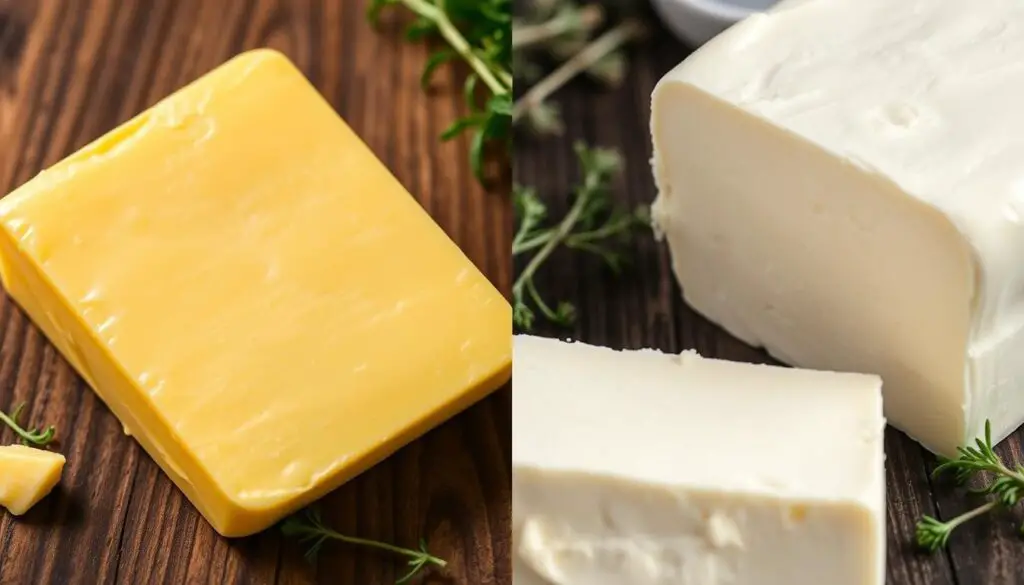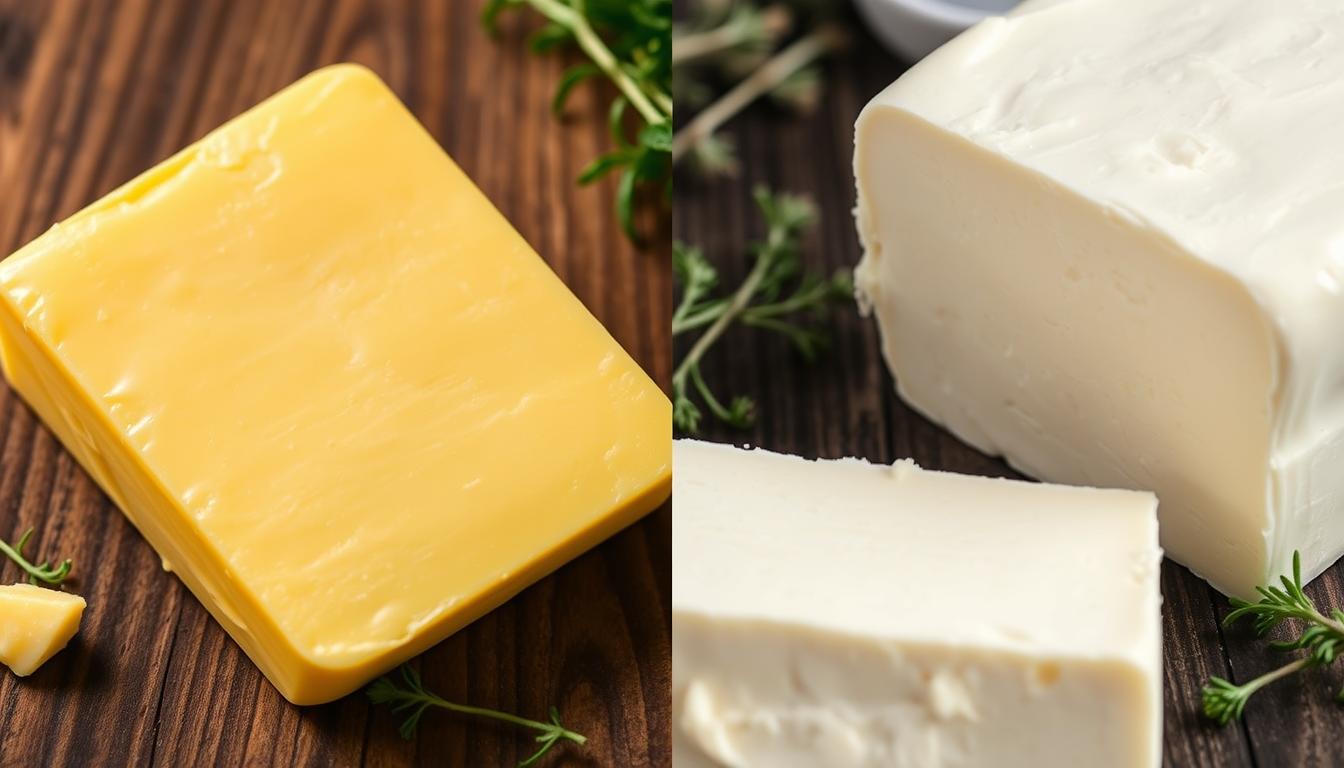Butter and cream cheese are both loved in cooking and baking. However, they are made differently and have unique nutritional values. Knowing these differences helps us choose better for our diets.

Butter comes from churning cream. Cream cheese, on the other hand, is made by mixing milk and cream with lactic acid bacteria. This makes butter higher in calories and fat, but cream cheese has more protein and vitamins.
Introduction
Butter and cream cheese are favorites in many recipes. They come from milk but are made differently. We’ll look at how they’re made and what they’re like.
General Overview of Butter and Cream Cheese
Butter is a solid fat made of churning cream or milk. This churning makes the fat globules stick together. Then, the solid fat is rinsed and sometimes salted.
Cream cheese is a soft cheese made by adding lactic acid bacteria to milk and cream. The milk solids are separated from the whey. Then, the curds are heated and packaged to become creamy and spreadable.
Differences in Production and Composition
Butter and cream cheese are made in different ways. Butter comes from churning cream or milk. Cream cheese is made by adding lactic acid bacteria to milk and cream. These different methods make them unique:
- Butter is almost all fat, with one tablespoon having over 11 grams of fat and 102 calories.
- Cream cheese has fewer calories and fat, with one tablespoon having about 50 calories and 5 grams of fat.
- Butter is solid, while cream cheese is soft and spreadable.
- Cream cheese has a bit of protein, but butter is mostly fat.
How much you use affects the calories and fat in butter and cream cheese. Your choice depends on your taste and diet.
Nutritional Comparison
Calories and Macronutrients
Butter and cream cheese differ in calories and macronutrients. Butter has 717 calories per 100 grams, more than cream cheese’s 350 calories. Butter is all fat, while cream cheese has 7% protein, 6% carbs, and 87% fat.
Micronutrients: Vitamins and Minerals
Butter and cream cheese also have different vitamins and minerals. Butter is high in vitamins A, E, and K. Cream cheese, on the other hand, has more B vitamins, calcium, phosphorus, and zinc. It also has more potassium, with 132mg per 100 grams compared to butter’s 24mg.
| Nutrient | Butter, Unsalted (per 100g) | Cream Cheese (per 100g) |
|---|---|---|
| Calories | 717 | 350 |
| Protein (g) | 0.85 | 6.2 |
| Carbohydrates (g) | 0 | 6 |
| Total Fat (g) | 81.1 | 28.6 |
| Saturated Fat (g) | 51.4 | 20.2 |
| Cholesterol (mg) | 215 | 101 |
| Calcium (mg) | 24 | 97 |
| Vitamin A (mcg) | 684 | 308 |
| Vitamin E (mg) | 2.3 | 0.86 |
| Potassium (mg) | 24 | 132 |
The differences in vitamins and minerals are key for those with special dietary needs or preferences.
Flavor and Texture
Butter and cream cheese have different tastes and textures. Butter tastes richer, creamier, and sometimes saltier, depending on its type. Cream cheese, on the other hand, has a lighter, tangier flavor that’s a bit acidic.
Their textures also vary. Butter is solid and firm when it’s cool, perfect for baking and sautéing. Cream cheese is softer and spreadable, great for spreads, dips, and frostings.
| Characteristic | Butter | Cream Cheese |
|---|---|---|
| Flavor | Richer, creamier, and sometimes saltier | Lighter, tangier, and slightly acidic |
| Texture | More solid and firm at cooler temperatures | Softer and more spreadable |
| Culinary Applications | Baking, sautéing | Spreads, dips, frostings |
These differences in flavor and texture mean butter and cream cheese are good for different things in the kitchen. They show how versatile they are.
“Butter and cream cheese may seem similar, but their unique flavor profiles and textural characteristics make them invaluable in the culinary world.”
Butter vs Cream Cheese – What’s The Difference?
Distinct Characteristics and Uses
Butter and cream cheese are both dairy products, but they’re used in different ways. Butter is great for baking, sautéing, and adding richness to food. It has a high-fat content and a creamy texture. Cream cheese, on the other hand, is perfect for spreads, dips, and frostings. It’s also used in baked goods like cheesecake.
Butter and cream cheese have different nutrients, flavors, and textures. This makes them good together in the kitchen. Butter’s high-fat content and savory taste are perfect for baked goods. Cream cheese’s tangy, creamy taste is great for spreads, dips, and desserts.
- Butter is commonly used for baking, sautéing, and adding richness to dishes.
- Cream cheese is more often used as a spread, in dips and frostings, or baked goods like cheesecake.
- The differences in nutrient profiles, flavor, and texture make butter and cream cheese complementary ingredients in the kitchen.
Choosing between butter and cream cheese depends on the dish or recipe. It also depends on the flavor and texture you want. Knowing how to use each can help you make delicious, balanced dishes.

Health Impacts
Positive and Negative Effects of Butter
Butter has both good and bad sides for health. It has compounds like CLA and butyrate that may help fight inflammation and improve metabolism. It also has vitamins A, E, and K, which are important for our bodies.
But, butter is high in saturated fat and calories. Eating too much can lead to weight gain and increase heart disease risk.
Positive and Negative Effects of Cream Cheese
Cream cheese is lower in calories and saturated fat than butter. It can contribute to weight gain and heart issues if eaten too much. But, it has probiotics that can help our gut health.
It’s also lower in lactose, making it better for those with lactose intolerance. But, its saturated fat and preservatives in some brands are concerns.
| Nutrient | Butter (1 oz) | Cream Cheese (1 oz) | Neufchâtel Cheese (1 oz) | Kite Hill Almond Milk Cream Cheese (2 tbsp) |
|---|---|---|---|---|
| Calories | 102 | 99 | 72 | 70 |
| Protein (g) | 0.1 | 1.74 | 2.59 | 2 |
| Fat (g) | 11.5 | 9.75 | 6.46 | 6 |
| Saturated Fat (g) | 7.2 | 5.73 | 3.63 | 0 |
| Carbohydrates (g) | 0.0 | 1.56 | 1.32 | 0 |
| Vitamin A (mcg) | – | 87.3 | – | – |
When it comes to butter and cream cheese, eating in moderation is key. Both can offer some good nutrients but are high in fat and calories. To make them part of a healthy diet, pair them with foods like veggies, fruits, whole grains, nuts, seeds, and pulses.
Dietary Considerations
Thinking about adding butter and cream cheese to your diet? There are key things to keep in mind. For those on a keto or low-carb diet, both are good choices. Butter is mostly fat, with very little carbs. Cream cheese also has low carbs, fitting well into a keto or low-carb diet.
Keto and Low-Carb Diets
Butter’s high fat content makes it great for boosting fat on a keto diet. Cream cheese adds protein and calcium, which are also good. Both can be part of a healthy, balanced diet on a keto or low-carb diet.
Vegan and Dairy-Free Diets
Butter and cream cheese aren’t right for vegan or dairy-free diets. They come from dairy. Vegans and those avoiding dairy can try plant-based butter substitutes or dairy-free cream cheese alternatives. These can be made from nuts, seeds, soy, or coconut.

Choosing between butter, cream cheese, or their alternatives depends on your diet and health goals. Talking to a healthcare pro or dietitian can offer tailored advice. They can help find the best fit for you.
Cost and Availability
The price of butter and cream cheese can change based on the brand, where you buy it, and the store. Butter is usually cheaper than cream cheese. For example, a 16-ounce block of store-brand butter costs about $3.68. On the other hand, an 8-ounce block of Philadelphia Cream Cheese is around $2.98.
You can find both butter and cream cheese at most grocery stores, supermarkets, and specialty shops. This makes them easy to get for most people. But, their prices have gone up in recent years. This is because of higher production costs and more people wanting them.
| Product | Average Price (16 oz) | Availability |
|---|---|---|
| Butter | $3.68 | Widely available at grocery stores, supermarkets, and specialty retailers |
| Cream Cheese | $2.98 (8 oz) | Widely available at grocery stores, supermarkets, and specialty retailers |
The cost of butter and cream cheese has gone up for several reasons. These include higher production costs, more demand, and problems in the supply chain. Milk processors have raised prices for high-fat dairy products by 10-30%. This has led to a big increase in the prices of butter and cream cheese at stores.
Even with the higher prices, butter and cream cheese are easy to find in the U.S. You can usually find them at your local grocery stores, supermarkets, and specialty shops. This gives shoppers many options to choose from.
Conclusion
In conclusion, butter and cream cheese are both popular dairy products. They have different production methods, nutritional profiles, and uses in cooking. Summary of butter vs cream cheese, butter has more calories, fat, and saturated fat. But it also has beneficial compounds and vitamins.
Cream cheese, on the other hand, has fewer calories and fat. It is richer in protein, calcium, and vitamins and minerals. This makes it a good choice for those looking for a healthier option.
Key differences between butter and cream cheese include how they are processed and their fat and protein content. They also offer different nutrients. Knowing these differences helps people make better choices based on their diet and recipes.
When deciding which one to choose, it depends on personal taste, diet goals, and how you plan to use it. Both can be part of a healthy diet when enjoyed in moderation. They suit different recipes and dietary needs.









